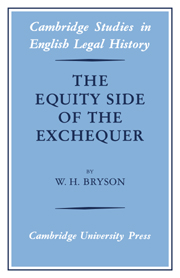Crossref Citations
This Book has been
cited by the following publications. This list is generated based on data provided by Crossref.
Carter, Jennifer
1979.
The Restored Monarchy 1660–1688.
p.
71.
Johnson, George W.
1979.
1978 Annual Supplement.
p.
1.
Lidington, D.R.
1984.
Mesne process in penal actions at the Elizabethan exchequer.
The Journal of Legal History,
Vol. 5,
Issue. 3,
p.
33.
Busch, Allan J.
1989.
The John Lisle Chancery manuscripts: The ‘pleas and demurrers’.
The Journal of Legal History,
Vol. 10,
Issue. 3,
p.
327.
Ball, R.M.
1990.
Tobias Eden, change and conflict in the exchequer office, 1672–16981.
The Journal of Legal History,
Vol. 11,
Issue. 1,
p.
70.
Ball, R.M.
1990.
The King's Remembrancer's office in the eighteenth century1.
The Journal of Legal History,
Vol. 11,
Issue. 1,
p.
90.
Fox, Adam
1996.
The Experience of Authority in Early Modern England.
p.
89.
Horwitz, Henry
and
Polden, Patrick
1996.
Continuity or Change in the Court of Chancery in the Seventeenth and Eighteenth Centuries?.
Journal of British Studies,
Vol. 35,
Issue. 1,
p.
24.
Haskett, Timothy S.
1996.
The Medieval English Court of Chancery.
Law and History Review,
Vol. 14,
Issue. 2,
p.
245.
Neufeld, Matthew
and
Hatcher, Rachel
2017.
Civil War and Narrative.
p.
191.
Waddell, Brodie
2024.
The Popular Politics of Local Petitioning in Early Modern England.
Journal of British Studies,
p.
1.





